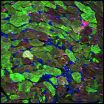(Press-News.org) HEIDELBERG, 18 December 2014 - The quality of the colon mucus in mice depends on the composition of gut microbiota, reports a Swedish-Norwegian team of researchers from the University of Gothenburg and the Norwegian University of Life Sciences in Oslo. The work, published in EMBO reports, suggests that bacteria in the gut affect mucus barrier properties in ways that can have implications for health and disease.
"Genetically similar mice with subtle but stable and transmissible intestinal microbiota showed unexpectedly large differences in the inner colon mucus layer. The composition of the gut microbiota has significant effects on mucus properties," says Malin E.V. Johansson from the University of Gothenburg who led the study.
By sequencing the microbiota and examining the 16S ribosomal RNA genes, the researchers discovered that two mouse colonies maintained in two different rooms in the same specific pathogen-free facility had different gut microbiota. They also had a mucus structure that was specific for each colony. Whereas one colony developed mucus that was not penetrable to bacteria, the other colony had an inner mucus layer permeable to bacteria.
Each group of mice had a stable population of bacteria that could be maternally transmitted: The group with impenetrable mucus had increased amounts of Erysipelotrichi bacteria, while the other group had higher levels of Proteobacteria and TM7 bacteria in the distal colon mucus. Free-living mice from the forest had mucus similar in composition to that found in mice in the non-penetrable colony. The authors also showed that the bacterial composition could be modulated to a small extent through the diet.
"The results from the free-living mice strongly argue for the importance of a well-developed inner mucus layer that efficiently separates bacteria from the host epithelium for the overall health of the mice," says Johansson.
The different mucus properties were recreated by transplanting the microbial communities into germ-free mice. "After recolonisation of germ-free mice with the different microbiota we observed the same structural and functional differences in their mucus properties," added Johansson.
Mucus is our outermost barrier to our microbiota in the gut. If the mucus fails to offer a protective barrier it can allow more bacteria to come in contact with our epithelium in a way that can trigger colon inflammation. Diseases such as ulcerative colitis show an increased incidence in the Western world and this study emphasizes the importance of the composition of the microbiota for an impenetrable protective mucus barrier.
INFORMATION:
The gut microbiota composition impairs the colon inner mucus layer barrier
Hedvig E Jakobsson, Ana M Rodríguez-Piñeiro, André Schütte, Anna Ermund, Preben Boysen, Mats Bemark, Felix Sommer, Fredrik Bäckhed, Gunnar C Hansson, and Malin E V Johansson.
Read the paper: http://embor.embopress.org/content/early/2014/12/17/embr.201439263
doi: 10.15252/embr.201439263
Further information on EMBO reports is available at http://www.embor.embopress.org
Media Contacts
Yvonne Kaul
Communications Officer
yvonne.kaul@embo.org
Nonia Pariente
Editor, EMBO reports
Tel: +49 6221 8891 305
nonia.pariente@embo.org
About EMBO
EMBO is an organization of more than 1700 leading researchers that promotes excellence in the life sciences. The major goals of the organization are to support talented researchers at all stages of their careers, stimulate the exchange of scientific information, and help build a European research environment where scientists can achieve their best work.
EMBO helps young scientists to advance their research, promote their international reputations and ensure their mobility. Courses, workshops, conferences and scientific journals disseminate the latest research and offer training in techniques to maintain high standards of excellence in research practice. EMBO helps to shape science and research policy by seeking input and feedback from our community and by following closely the trends in science in Europe.
For more information: http://www.embo.org
Eating bilberries diminishes the adverse effects of a high-fat diet, according to a recent study at the University of Eastern Finland. For the first time, bilberries were shown to have beneficial effects on both blood pressure and nutrition-derived inflammatory responses.
Low-grade inflammation and elevated blood pressure are often associated with obesity-related diseases. The study focused on the health effects of bilberries on mice that were fed high-fat diet for a period of three months. Some of the mice were fed either 5% or 10% of freeze-dried bilberries in the diet. ...
The enzyme telomerase repairs cell damage produced by ageing, and has been used successfully in therapies to lengthen the life of mice. Now it has been observed that it could also be used to cure illnesses related to the ageing process. Researchers at the Spanish National Cancer Research Centre (CNIO) have for the first time treated myocardial infarction with telomerase by designing a very innovative strategy: a gene therapy that reactivates the telomerase gene only in the heart of adult mice, thus increasing survival rates in those animals by 17 % following a heart attack.
Christian ...
Researchers from North Carolina State University have found a way of binding peptides to the surface of gallium nitride (GaN) in a way that keeps the peptides stable even when exposed to water and radiation. The discovery moves researchers one step closer to developing a new range of biosensors for use in medical and biological research applications.
GaN is a biocompatible material that fluoresces, or lights up, when exposed to radiation. Researchers are interested in taking advantage of this characteristic to make biosensors that can sense specific molecules, or "analytes," ...
This news release is available in German.
Physicists are continuously advancing the control they can exert over matter. A German-Spanish team working with researchers from the Max Planck Institute for Nuclear Physics in Heidelberg has now become the first to image the motion of the two electrons in a helium atom and even to control this electronic partner dance. The scientists are succeeding in this task with the aid of different laser pulses which they timed very accurately with respect to each other. They employed a combination of visible flashes of light and ...
Trophoblasts, cells that form an outer layer around a fertilized egg and develop into the major part of the placenta, have now been shown to respond to inflammatory danger signals, researchers from Norwegian University of Science and Technology (NTNU) found in a recent study published in Journal of Reproductive Immunology December 2014.
The researchers said their findings were an important step in understanding how inflammatory responses in the placenta can contribute to the development of pregnancy disorders such as preeclampsia.
The trophoblast inflammatory response ...
This news release is available in German.
Puebla del Guzman (Andalusia) / Magdeburg. Being part of the mining area Herrerias in Andalusia, deep waters of Pit Lake Guadiana show extremely high concentration of dissolved carbon dioxide (CO2). In the case of a spontaneous ebullition, human beings close-by would be jeopardized. To demonstrate the danger and the possible solution, scientists of the Spanish Institute of Geology and Mining, the University of the Basque Country (UPV/EHU, Bilbao) and the Helmholtz Centre for Environmental Research (UFZ) constructed a pilot ...
Chlorine is a common disinfectant that is used to kill bacteria, for example in swimming pools and drinking water supplies. Our immune system also produces chlorine, which causes proteins in bacteria to lose their natural folding. These unfolded proteins then begin to clump and lose their function. RUB researchers headed by Prof Dr Lars Leichert have discovered a protein in the intestinal bacterium E. coli that protects bacteria from chlorine. In the presence of chlorine, it tightly bonds with other proteins, thus preventing them from coagulating. Once the danger has passed, ...
This news release is available in German. A team of scientists headed by Dr. Florian Bassermann at the III. Medizinische Klinik, TUM Klinikum rechts der Isar, has been investigating mantle cell lymphoma, a subgroup of non-Hodgkin's lymphoma, which, despite new therapies, has poor patient survival rates. "Programmed cell death no longer functions in many lymphoma cells. This causes them to multiply uncontrollably. We urgently need to find out what's going wrong in these cells in order to find new treatment therapies," explains Bassermann.
The scientists started analyzing ...
A new study shows that many patients infected with the hepatitis C virus (HCV) are lost during different stages of health care to manage the disease. This real-life' view of the HCV patient care continuum in a major U.S. urban area is published in Hepatology, a journal of the American Association for the Study of Liver Diseases, and highlights the importance of generating awareness among clinicians and at-risk groups about appropriate HCV testing, referral, support and care.
Despite efforts to manage HCV, it is one of the most prevalent diseases with up to 150 million ...
Hydrogen peroxide (H2O2) is a strong oxidizer and is used as a bleaching agent for hair and teeth, and as a wound disinfectant. In addition, H2O2 also forms in the body, for example as a metabolic product of cellular respiration. It belongs to a group of chemicals called reactive oxygen species (ROS), which scientists suspect to have a damaging effect on cells and their components. For example, they are believed to play a role in carcinogenesis, degenerative diseases, and even aging. Body cells contain large quantities of enzymes called peroxiredoxins that degrade H2O2 ...



